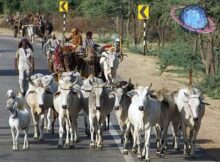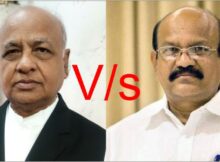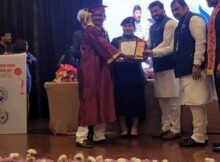Rashtriya Krishi Vikas Yojana (राष्ट्रीय कृषि विकास योजना) is a special Additional Central Assistance Scheme which was launched in August 2007 to orient agricultural development strategies, to reaffirm its commitment to achieve 4 per cent annual growth in the agricultural sector during the 11th plan. The scheme was launched to incentivize the States to provide additional resources in their State Plans over and above their baseline expenditure to bridge critical gaps.
Sectors Covered
The RKVY covers all sectors such as Crop Cultivation, Horticulture, Animal Husbandry and Fisheries, Dairy Development, Agricultural Research and Education, Forestry and Wildlife, Plantation and Agricultural Marketing, Food Storage and Warehousing, Soil and Water Conservation, Agricultural Financial Institutions, other Agricultural Programmes and Cooperation.
Incentivize the States
RKVY is a State Plan Scheme. How much assistance would be provided to a state from centre would depend upon the amount provided in State Plan Budgets for Agriculture and allied sectors, above a baseline expenditure on these sectors.
This means that eligibility of a state for the RKVY is contingent upon the state maintaining or increasing the State Plan expenditure for Agriculture & Allied Sectors. The base line expenditure is determined based on the average expenditure incurred by the State Government during the three years prior to the previous year.
The RKVY funds are provided to the states as 100% grant by the Central Government.
How states become eligible?
The states are mandatorily required to prepare the District and State Agriculture Plans that comprehensively cover resources and indicate definite action plans.
States are encouraged to converge the scheme with other programmes such as NREGS, SGSY, BRGF, etc. If the state lowers its investment in the subsequent years, and goes out of the RKVY basket, then the balance resources for completing the projects already commenced would have to be committed by them.
RKVY is an incentive scheme so money is not allocated to the states automatically. The more the states encourage the agriculture and allied fields, the more incentive they get from central government. However, high level of flexibility has been provided to the states including at the level of the state Government.
How money flows?
The Nodal department for the scheme in the states is the State Agriculture Department. The department is required to take appropriate steps for identification of the projects that are important for agriculture, horticulture and allied sector development. If the government of the state is in hurry, it can also constitute an agency by notification for implementation of the RKVY. If the state does so, the funds would be disbursed to this agency but the administrative expenses of such agency can not exceed 1% of total allocation under RKVY.
This agency or the state department of agriculture will ensure the preparation of the DAPs (District Action Plans) and preparing the SAP (State Action Plan).
A District Agriculture Plan (DAP) for each district should be formulated as per the Planning Commission guidelines. The DAP should include clear roadmap of the sectors. Then, the comprehensive State Agriculture Plan (SAP) should evolve out of the DAPs. Finalized SAP should be placed by the State Planning Department before the Department of Agriculture /Planning Commission, as a part of the State Plan Exercise.
The determination of eligibility is done by Planning Commission. How much money should be allocated is also determined by the Planning Commission.
Once the state becomes eligible, the Distribution of Funds is done by the Department of Agriculture (DAC), under the Ministry of Agriculture.
The money is released to the state governments. For further flow of the money, the state government is required to create a State Level Sanctioning Committee (SLSC) constituted under the Chairmanship of the Chief Secretary of the concerned State Government/UT. This SLSC approve the projects under RKVY to the agency.
Here we should note that the money that is released is in two streams. Up to 75% of the money is released under stream-1 only by the SLSC whereby the money is used for project based funding with definite timelines. For expenditure of this money, states will have to prepare DPRs for undertaking projects that are consistent with the SAPs and DAPs. Rest maximum 25% of the funds can be spend for stregthening the existing schemes. However, there are options that all money is used as per stream-1.
Composition of SLSC
Please note that the SLSC is chaired by the Chief Secretary of the state and its vice chairman is Principal secretary of agriculture in state departments. It has representations from the DAC, DAHD, and Planning Commission. The quorum for its meeting is incomplete without at least one GoI representative. It must meet in a quarter for at least once.
Outlay
The total outlay of this scheme was kept ` 25,000 Crore for the 11th plan period in the form of Additional Central Assistance (ACA). Thus it became the biggest scheme in the agriculture sector. Despite the fact that India has not been able to achieve the targeted growth in farm sector, the scheme has been continued with increased outlays and increase number of sub schemes every year. Areas of focus of these schemes has been Seeds, fertilizers, IPM Testing laboratories, Horticulture, Farm Mechanization, Extension, Crops, Marketing and Cooperatives,, animal husbandry etc.
Sub schemes
At present RKVY has following sub-schemes:
- Bringing Green Revolution to Eastern India (BGREI): Targets improvement in the rice based cropping systems of Assam, West Bengal, Orissa, Bihar, Jharkhand, eastern Uttar Pradesh and Chhattisgarh.
- Integrated Development of 60,000 Pulses Villages in Rainfed Areas
- Promotion of Oil Palm
- Initiative on Vegetable Clusters
- Nutri-cereals: To promote balanced nutrition, higher production of bajra, jowar, ragi and other millets will be promoted.
- National Mission for Protein Supplements: To take up activities to promote animal based protein production through livestock development, dairy farming, piggery, goat rearing and fisheries in selected blocks.
- Accelerated Fodder Development Programme: To accelerate the production of fodder through intensive promotion of technologies to ensure its availability throughout the year.
- Rainfed Area Development Programme: This programme aims at improving productivity of crops in rainfed areas.
- National Saffron Mission: This programme aims at revival of saffron cultivation in Jammu & Kashmir.
- A new programme called Vidarbha Intensified Irrigation Development Programme was launched with allocation of Rs. 300 Crore.









